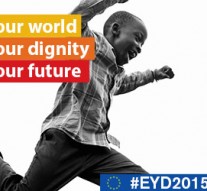
Development and security: what to expect from the European Year for Development
External Relations 15 June 2015“Our world, our future, our dignity” is the catchphrase for the European Year for Development. 2015 is expected to be the watershed year for development with the deadline for achieving the Millennium Development Goals, the UN Special Summit on Sustainable Development Goals, and the Paris Climate Conference.
Both a new beginning and a deadline, the European Year for Development coincides with the culmination of the post-2015 debate, but not by coincidence.
While aimed at raising European citizens’ awareness about the European development policies, the EYD is sending a strong signal about its political significance, being the first year focused on the European External Action.
But why does the EYD seem to be so important for European external policies?
As the HR/VP Federica Mogherini recently declared, there’s no sustainable development without peace and security, and that, vice versa, without development and poverty eradication there will be no lasting peace. The interdependence between conflict and poverty, also known as security-development nexus, is among the root causes of weak governance and instability.
As World Development reports 2011 points out, the lack of peace and security keeps people locked in cycles of insecurity and poverty and seriously compromises sustainable development.
The European Union and its 28 Member States together remain the world’s biggest aid donor. In 2013 they provided €56.5 billion in official development assistance – more than half of global official aid. As a driving force for international cooperation, the EU not only provides financial support but also pushes international debate forward, trying to harmonize external policies and development objectives.
In this context, the EU recognizes the need for conflict prevention and the importance to address state fragility through development cooperation. Through its ‘Agenda for Change’, in 2011 the EU adopted a strategy designed to transform the way in which Europe fights poverty, with funds targeted at those countries most in need and at a limited number of sectors where the greatest impact and results can be achieved.
Furthermore, the Lisbon Treaty has explicitly enshrined, as one of the objectives of the EU’s external action “to preserve peace, prevent conflicts and strengthen international security, in accordance with the purposes and principles of the United Nations Charter (Article 21(c) TEU).
In this way, the so-called security-development nexus has become an underlying principle of the EU’s comprehensive approach and, as the security situation in many parts of the globe has deteriorated over the last years, the EU has been committed to provide security in its neighbourhood and beyond.
Currently, the EU is deploying 16 civilian and military CSDP (Common Security and Defence Policy) missions aimed at preserving and strengthening international security and enabling the EU to take a leading role in conflict prevention.
For this purpose, the EU has mobilized resources across the full range of diplomatic, security, economic, development and humanitarian instruments at its disposal through which it provides assistance to fragile countries, promoting good governance and Rule of Law.
From this point of view, the EU’s ability to create cross sectorial synergies was one of the added values in responding to emergencies and trying to achieve long-term objectives. This sort of harmonization between security and humanitarian goals has been firstly put in place with the African Peace Facility, a financial instrument aimed at increasing and reinforcing the capacity building and to address emerging threats that could risk to compromise development and cooperation objectives.
Furthermore, while perceived as an ambitious external policy, this comprehensive approach arose some concerns on the possibility that foreign policy objectives might dominate over development principles and humanitarian action. In particular, the EP’s DEVE Commission emphasizes how important it is to bridge the gap between security and development, without marginalizing humanitarian goals in favour of political ends.
Translating the security-development nexus into practice is crucial and complex. Skepticism revolving around the EU’s ability to adopt a more comprehensive approach that links emergency assistance, long-term development and international stability, still persist.
Encouraging the debate and the exchange of views, the European Year for Development is providing an opportunity to reach out to a wider public regarding the importance of the development agenda. Now it is up to the European Union, namely the MS governments, to take the best from this initiative, in order to make development policies an investment both on security and peace.






